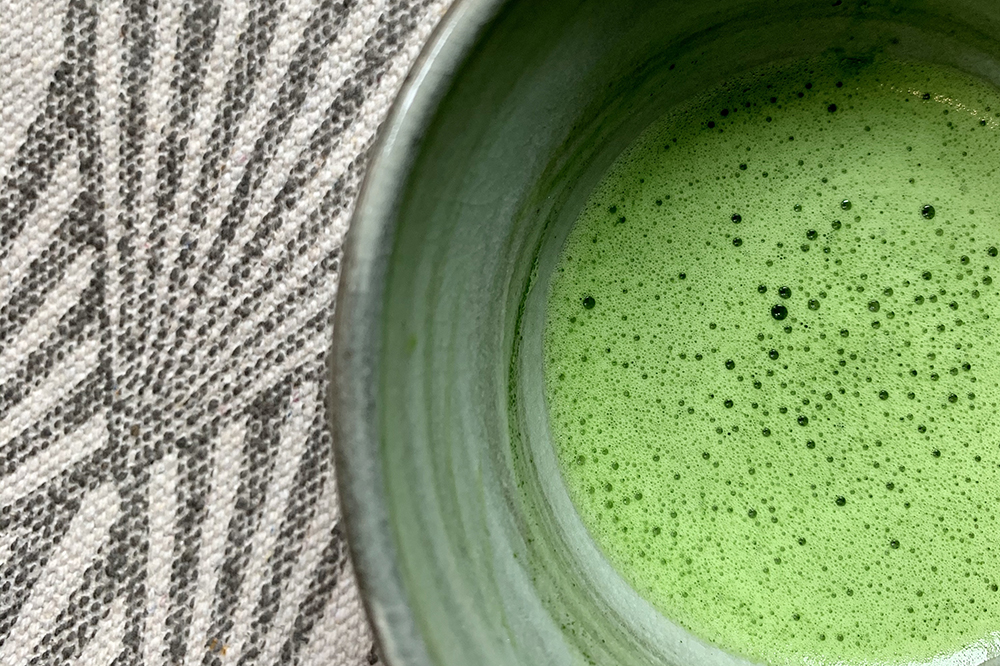Drink
 Matcha. Photo courtesy of Teaism.
Matcha. Photo courtesy of Teaism.
A Love Letter to Tea in the District + Beyond
December 1, 2023 @ 1:00pm
District Fray’s Nicole Schaller reflects on the role tea plays in her life — at work, home, and abroad — and speaks to locals on where to get great tea in D.C.
From the hours I spend writing — whether it be at my apartment, at a cafe or at an office cubicle — to the times when I meet up with friends to when I curl up and read a book, tea is always there. When I am sick, I grab mint or chamomile. When I am tired (most days), I reach for a green tea variety. And when I am looking for a pick-me-up or a way to make the day feel less monotonous, chai is my reliable sidekick. No matter the circumstance or memory attached, tea has always been a comfort for me.
For owner Yunhan Zhang of Valley Brook Tea, relocated from its P Street location to a block away inside The Ven at Embassy Row, he views tea as an unremarkable constant in his life.
“Where I am from in China, it is extremely tea-loving because we produce the most tea and the most teaware,” Zhang says as he refills my cup of oolong during a Valley Brook Tea service. “At the bank, the bank manager will be pouring and providing tea in the bank lobby. You go to the dentist or a business meeting, tea is the center of the stage. It’s always been there. We don’t have a tea ceremony, because it doesn’t need to be celebrated. It’s a daily thing. You don’t celebrate going to work every day but you might celebrate a promotion. If you celebrate tea that means tea is not exactly in your life.”
Tea for Zhang not only runs in his cultural background but also within his family. Valley Brook Tea is a family-owned and operated tea business. Zhang’s family owns three mountains in Fujian, China, where tea leaves have been grown and cultivated for generations. All of Valley Brook’s teas at their shop and tea house are sourced from his family’s mountains.
Zhang takes pride in offering premium-quality tea from the land he was raised on to a clientele who often accepts subpar teas for the sake of accessibility.
“There are so many things about what makes tea good, which I didn’t know until I came to the States because before then, I never had a bad tea in my life,” Zhang says. “At the end of the day, the basic idea is that we present the most authentic, unaltered tea in a way that’s familiar to you.”
Like Zhang, the retail and social media manager of Teaism, Lela Singh, also has family ties to the tea business. As a mainstay tea house and shop since 1996 with several locations throughout D.C., Teaism was co-founded by Singh’s mother Michelle Brown, along with Linda Neumann.
As a child, Singh has fond memories of helping her mother at the first Teaism location in Dupont Circle. With her father’s family from India, Singh recalls the routine chai brewing on the stove growing up, especially when family came over.
“Tea just breaks up your day,” Singh says as she sips on some loose-leaf green tea. “I had this memory come back to me recently. I used to do this really annoying thing as a kid playing make believe with other kids. We pretended someone was injured or sick, and I would pretend to make a tea to make them all better. I’d run around and grab sticks and stones and mash them up and then shove them in the kid’s face, like, ‘Here’s your tea.’ I had it in my head, ‘I’m going to make tea and fix you with it.’”
Her love for healing people through tea manifested in her ongoing pursuit to learn about tea varieties ranging from China, Japan and Nepal. While working out of a tea house in Seattle in her early 20s, she took the time to independently educate herself on sourcing the best tea types of each tea variety and understanding the different notes, flavors and depths of tea.
How tea is derived is an ongoing education for me.
On a mountain on the island of Samos, Greece, my great aunt, Thea Soula, showed me to my room overlooking my family’s garden. As she opened the door, shriveled gold flowers were laid on a sheet atop the bed, evenly spaced out.
“Khamaimelon,” she told me as she carefully lifted the sheet and moved it to her bedroom to finish drying the chamomile flowers. For every fall as long as I can remember, my yiayia brought reused jam jars full of dried chamomile to the U.S. she had picked in Greece that summer. I never really thought about the processing of the tea until I saw the flowers drying when visiting in 2016. For me, it always arrived in an unmarked jar and I would boil with water before straining and enjoying on a day when I needed to feel soothed.
“We need to know what makes tea good and what makes tea better, but our customers don’t need to know,” Zhang says. “When you open a bar you need to know what’s a good beer, but customers don’t need to.”
At Valley Brook, they have curated their tea menu to introduce their most popular teas to people through a clever tactic. Whether you choose from their oolong, green, black or white list of teas, each section has one tea name in English and the rest of the tea varieties in their traditional Chinese names. Without realizing, I fell into the trap. I ordered the Golden Peony oolong because I felt the most confident pronouncing it and didn’t want to embarrass myself in front of Zhang.
“We know what kind of struggle people might have pronouncing the tea name,” Zhang says. “We needed to find a way to present it that is not threatening. We don’t want to call everything in a name where you cannot know the original tea name, though.”
The goal is for people to get comfortable with the most introductory teas of each variety before venturing into more niche ones that have their proper names listed.
While it would be nice for Zhang to always be able to prepare you a cup, for tea drinkers who want to move past casual drinking and learn how to make a proper cup of tea at home, Singh recommends exploring the tea you like and simplifying the process.
“I came into my own as a tea drinker in college because I was out in the world and I had to figure out how to access comfort,” Singh says. “Chai was always made for me at home. It was a given. Then when I went off to college, I was like, ‘I have to make this happen for myself. I need fresh ginger, I need fennel, I need to go to the Indian store, I need to get the spices that I want.’”
Once she was able to brew a chai that pleased her palate, Singh would invite her friends over to study together and she would serve them chai. At the Teaism Shop in Penn Quarter, there are a variety of tools one can choose from to start regularly preparing tea at home.
To start out, Singh recommends the Forlife extra fine metal tea strainer that you can place in a mug and pour hot water directly over the loose-leaf tea in the strainer, or add loose-leaf tea to the strainer and add the strainer to a mug of hot water. She believes steeping tea for as long as you personally prefer as some prefer stronger tasting tea and others prefer weaker tasting tea.
“With the brewing equipment, don’t get freaked out,” Singh says. “We have mugs. We have teapots. We have strainers. Remember it’s leaves in water. If it gets bitter, dilute it out. It is not the end of the world.”
Zhang takes a more scientific and objective approach to tea preparation, which he shares on his blog on Valley Brook Tea’s website. With 173 entries and counting, Zhang provides insight on the best practices for the best possible brew, including choosing quality water (sorry D.C. tap water), temperatures for each tea (boiling at 212°F, except for green tea which should be brewed at 176°F) and how long to steep each type of tea, which is surprisingly shorter than expected (Zhang advocates almost immediately for most teas if they are high quality).
Zhang strongly believes the best way to drink tea is through small batches where the hot water is poured into a cup of loose-leaf tea and then strained into another vessel before being poured into your cup, which is much smaller than your average Western-sized mug. This results in multiple rounds of tea service that becomes a delightful ritual. Both Teaism and Valley Brook sell tea sets where you can brew in this style.
To learn how to pour tea in this way, Zhang recommends trying out the Valley Brook Tea service for yourself. Beyond normal hours, every Sunday morning from 11:30 a.m. – 12 p.m., Valley Brook offers a free tea tasting where someone from Valley Brook Tea will guide you through a service and allow you to sample teas.
Zhang’s aim is to be approachable, a sentiment Singh also shares. She encourages people to visit the Teaism retail shop in Penn Quarter and she will personally help walk you through finding a tea that is right for your palate and how to properly brew it.
“I’ll brew you a cup. I’ll show you how to properly whisk matcha. I like to talk one-on-one because then I can meet you where you’re at.”
Wherever you are in your tea journey, there are experts in D.C. willing to help out. All you need is water and leaves.
Let the memories begin.
The D.C. Tea Guide
For quality service: Valley Brook in The Ven Embassy Row
2015 Massachusetts Ave. NW, DC; valleybrooktea.com // @valleybrooktea
View this post on Instagram
For studying: Teaism in Dupont Circle
2009 R St. NW, DC; teaism.com // @teaism_dc
View this post on Instagram
For unplugging with friends: Ching Ching Cha in Dupont Circle
1314 21st St. NW, DC; chingchingcha.com // @chingchingcha
View this post on Instagram
For holiday shopping: Teaism Shop in Penn Quarter (for a post-shopping snack, head to their tea house next door)
400 8th St. NW, DC; teaism.com // @teaism_dc
View this post on Instagram
For high tea: Blue Duck Tavern (serves Valley Brook Tea with their seasonal pairing menu)
1201 24th St. NW, DC; blueducktavern.com // @blueducktavern
View this post on Instagram
For a post-tour stop: Teaism at Lafayette Park
800 Connecticut Ave. NW, DC; teaism.com // @teaism_dc
View this post on Instagram
Want to discover more about D.C.’s drink culture? Join the District Fray community for exclusive access to drink experiences citywide. Become a member and support local journalism today.







